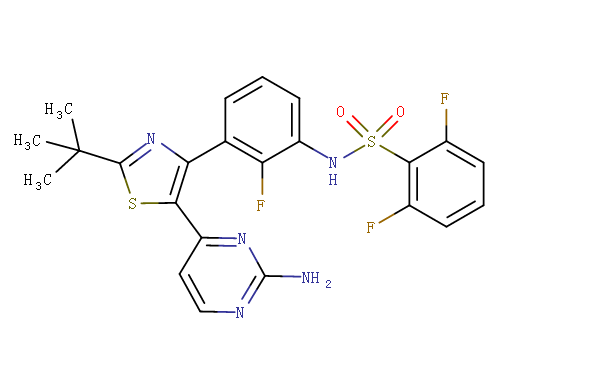Dabrafenib
Other name
-
International/Other brands
Tafinlar
Groups
Approved
Structure

Prescription products
| Name | Dosage | Strength | Route | Labeller |
|---|---|---|---|---|
| Tafinlar | Capsule | 50 mg | Oral | Novartis |
| Tafinlar | Capsule | 50 mg/1 | Oral | Novartis |
| Tafinlar | Capsule | 50 mg/1 | Oral | Glaxosmithkline Inc |
| Tafinlar | Capsule | 75 mg/1 | Oral | Novartis |
| Tafinlar | Capsule | 75 mg | Oral | Novartis |
| Tafinlar | Capsule | 75 mg/1 | Oral | Glaxosmithkline Inc |
Target
Description
Dabrafenib mesylate is a reversible ATP-competitive kinase inhibitor and targets the MAPK pathway. FDA approved on May 29, 2013.
Indications
Dabrafenib is indicated for the treatment of patients with unresectable or metastatic melanoma with BRAF V600E mutation as detected by an FDA-approved test.
Other indications
-
Mechaism of action
-
Absorption
After oral administration, median time to achieve peak plasma concentration (Tmax) is 2 hours. Mean absolute bioavailability of oral dabrafenib is 95%.
Metabolism
Dabrafenib is hepatically metabolized. The biotransformation process is primarily mediated by CYP2C8 and CYP3A4 to form hydroxy-debrafenib. This metabolite is further oxidized via CYP3A4 to form carboxy-dabrafenib and subsequently excreted in bile and urine. Carboxy-dabrafenib can also undergo decarboxylation to form desmethyl-dabrafenib, which may be reabsorbed from the gut. Desmethyl-dabrafenib is further metabolized by CYP3A4 to oxidative metabolites.
Toxicity
Most common adverse reactions (≥20%) for dabrafenib are hyperkeratosis, headache, pyrexia, arthralgia, papilloma, alopecia, and palmar-plantar erythrodysesthesia syndrome.